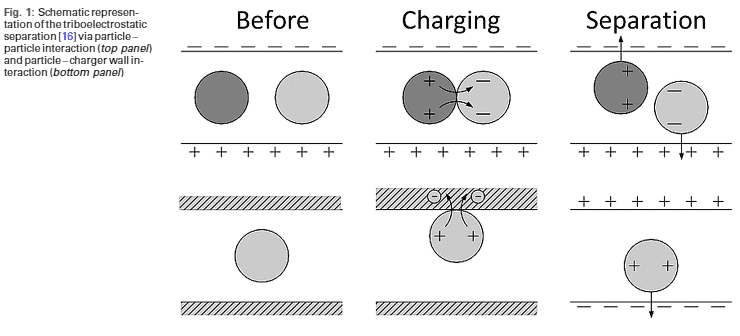Wybierz język:
Monika Mirkowska, Markus Kratzer, Christian Teichert, i Helmut Flachberger
Abstrakcja
Triboelectrostatic separation is a promising method used to separate non-conductive minerals. Jednak, the knowledge about the underlying triboelectrification mechanisms is still very limited. W ten sposób, predicting the separation results and finding proper separation parameters are challenging tasks. This article presents a comprehensive summary of phenomena and factors which play a decisive role in the charging behavior of non-conductors and, co za tym idzie, the efficiency of the separation process, such as water and adsorbents layers on the surface, Chropowatość powierzchni, wilgotność, rodzaj styku, itp. The authors hope that this article opens a way for a systematic approach through basic experiments dedicated to a better understanding of triboelectrification processes.
Słowa kluczowe: Separacja Triboelectrostatic, Triboelectrification, Kontakt ładowania, Minerały, Izolatory
Główne czynniki Triboaufladung Mineralphasenfür udanych elektrostatycznej separacji - einÜberblick
Krótki opis:Elektryczny rozwód reprezentuje obiecujące metody do Trennungnicht przewodzące fazy mineralne, po Triboaufla obornika. Ta ograniczona przewidywania się zwłaszcza do osiągnięcia rezultatów separacji, aby on się niełatwe zadanie Wissenüber pro sprawia, że są mechanizmy Triboaufla-obornika.
Niniejszej publikacji są zjawiska i czynniki wszechstronnej perspektywie SkyView, de podjąć decyzję dotyczące ładowania zachowanie dielektryki gry oder roli można i co miało wpływ na cinienia separacji. Czynniki te mogą być: Wody- i Adsorbatschichten, Oberflächenrauig-ness, Luftfeuchtigkeit, Kontaktart, USW. Die Autoren hoffen,dass dieser Artikel Wege für einen systematischen Ansatzdurch grundlegende wystawianą aufzeigt und damit zueinem besseren Verständnis der bei der Triboaufladungwirkenden Faktoren beiträgt.
Schlüsselwörter:Elektroscheidung, Triboaufladung,Mineralien, Isolatoren
Wprowadzenie
Separacja Triboelectrostatic jest techniką separacji environ psychicznie przyjazny tani, which has the potential to take over a greater significance of mineral processing and polymer recycling. It has been successfully applied for the separation of salts, calcite quartz, feldspar quartz, carbon as coal, and even for the purification of secondary materials like plastic. W ogóle, it is based on triboelectrification, which is the generation of net charges on insulating powder materials by bringing powder grains into contact with each other and the device walls. Ziarna, inaczej – opłata w wysokości po kontakcie, are separated in a strong electric field depending on the sign and amount of the charge they carry. Jednak, an application as a widespread separation method is limited due to the complexity of the involved interactions, which make it technologically difficult to adjust the proper process parameters. Different factors like the behavior of the powder stream, warunki środowiskowe (wilgotność, temperatury, itp), the mechanical and electrical properties of the individual grains as well as the design of the equipment have to be considered simultaneously. Especiallytriboelectrification/contact charging is a highly non-trivial phenomenon. So far no universal model for a quantitative or even qualitative description is available. W związku z tym, amain focus of this work is set on contact charging phenomena. We start with a brief description of the state of the art Triboelectrostatic separation technologies in Sect. 2. The discussion is continued with reviewing factors, which determine the charging behavior of insulators in Sect. 3. There the focus is set on triboelectric charging models, charge transfer mechanisms, influences like a type of contact and environment. In Sect. 4 we provide a short overview of experimental approaches for the investigations of electrification of minerals both at the macro- and micro scale. The authors hope that the article presents the complexity of the topic and will intensify systematic interdisciplinary investigations to a better understanding of triboelectrification processes. The considerations to follow are an integral part of the first author’s Ph.D. thesis, co jest w końcowej fazie.
